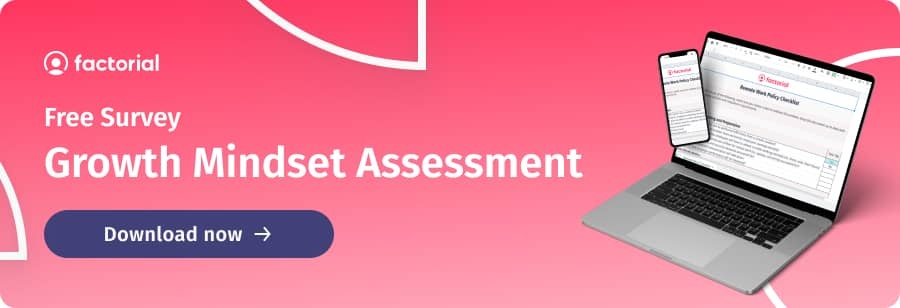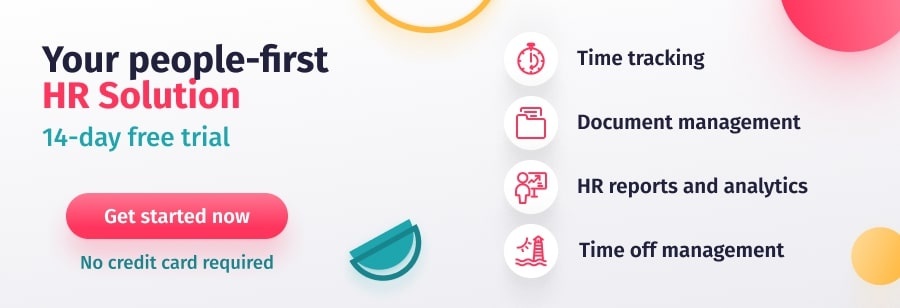Employers are under pressure to attract top talent and adapt to evolving employee expectations. Now is the time to create new ways of thinking and design new people management strategies to take your organization to the next level. One approach aimed at tackling this issue is design thinking in HR.
According to Deloitte, design thinking aims to improve productivity by putting the employee experience first. It’s about designing a productive and meaningful employee experience through solutions that are compelling, enjoyable, and simple.
Join us as we take a look at the design thinking process and the 5 key principles you need to keep in mind with this approach.

What is Design Thinking in HR?
So, what does the human principle of design thinking mean?
Design thinking is human-centered. It’s a form of analysis that puts the stakeholder at the center of the process in order to solve complex problems. In other words, finding solutions that respond to human needs and individual feedback.
The key aspect of an effective design thinking process is empathy. Instead of focusing on identifying, investigating, and solving an issue, the design thinking process is based on empathetic observations of how people respond to given situations. It’s all about putting yourself in someone else’s shoes and relying on feedback and experiences in order to find a solution.
Design thinking in HR means applying these human-centered design principles to your HR processes in order to improve the employee experience and, as a consequence, increase performance and productivity.
5 Key Design Thinking in HR Principles
Before we look at the different stages of a design thinking framework, let’s take a look at the 5 key principles that are pivotal to design thinking in HR.
User-Centricity and Empathy
The key foundation of design thinking in HR is empathy. It’s all about understanding the experiences of your employees and finding solutions that address their wants and needs. You need to step into the shoes of all your employees in order to gain a genuine understanding of their journey with your company. Make sure you are empathetic and see issues from their perspective at all times.
Collaboration
Design thinking is also centered around the concept of human collaboration. To get the most from the process, you need to collect a diverse range of perspectives and ideas. This will help you gain a fuller understanding of every experience with your company.
Ideation
Design thinking is a solution-based framework. What’s more, you should be continuously striving to find solutions as people’s needs are constantly evolving. Create a judgment-free environment where your team can generate, develop, and communicate new ideas on an ongoing basis. This is important because every idea is a fresh perspective that can help you gain a clearer understanding of the bigger picture.
Experimentation
Don’t stop at brainstorming. Experiment with new ideas and turn them into prototypes. Test them on sample groups and collect feedback. Tweak your ideas based on the feedback you collect. And remember that design thinking in HR is all about trial and error. Test, rinse, and repeat. Rome wasn’t built in a day, after all.
Action
Finally, remember that design thinking is a hands-on approach to problem-solving. This means you need to put your words into action. Instead of holding endless discussions about what might improve the experience in your company, engage with your employees. Test your prototypes and don’t be disheartened if feedback isn’t what you expected. Involve your employees in the decision-making process and focus on creating innovative solutions that respond to their feedback.
Design Thinking Phases: What's Involved in the Design Thinking Process?
Now that we’ve looked at the key principles of design thinking in HR, let’s take a look at the different stages of a design thinking framework and how we apply these principles.
There are five key stages in the design thinking in HR processes:
Empathize
The first stage of the design thinking process is to observe objectively and without judgment. Collect feedback from your employees, share surveys, conduct interviews and hold observation sessions. Tune into your sense of empathy to help you see your HR processes from their perspectives. Focus on the human side of things. You’d be surprised what you can uncover if you take off your HR hat for a moment.
This stage aims to paint a clear picture of who your employees are, the challenges they face, and what needs and expectations you need to meet.
Define
The next stage involves analyzing the data you collect in stage 1 and reducing feedback to one core issue. This will help you define a clear problem statement that guides the rest of the process with a clear goal.
What have you learned about your employees? Which issue do most employees raise?
Ideate
Once you have observed your workforce and defined the issue you want to solve, it’s time for a bit of brainstorming. Sit your team down and encourage everyone to share ideas and perspectives. Make sure everyone understands that it is a safe space that is free from judgment – there are no wrong answers. Be open-minded, explore new angles, and think outside the box. Now is the time to be creative and let your imagination run free.
Prototype
Once you’ve brainstormed a variety of ideas and collected as many perspectives as possible, it’s time to convert your ideas into solutions. Select a few from your list and build on them in order to find the best solution. Make sure you focus at all times on the employee experience.
The prototypes you come up with at this stage will give you something tangible to test on your employees. This is crucial in maintaining a user-centric approach.
Test
Finally, the fifth stage in the process is testing your prototypes on your employees. This enables you to see whether or not your solution works well in a real-life setting, and if it solves the issue you were trying to address.
Run a few testing sessions and observe your employees as they interact with your prototype. Collect feedback and encourage your employees to share their honest opinions. You can then use this feedback to make improvements before investing in your final solution.

Design Thinking in HR Examples
Design thinking in HR can be used to improve a wide range of human resources functions. This includes attracting and recruiting top talent, finding the right learning and development opportunities, increasing performance, and finding solutions to retain talent so that employees become an even great asset for a business.
Here are a couple of examples of how you can use design thinking to improve your HR processes.
Design Thinking in HR for Learning & Development
You can use the design thinking process to improve your existing employee development plans and foster a more inclusive learning culture in your business. In fact, this is one of the most effective applications of the approach as it helps you get to the heart of what your employees really want and need to work on.
For example, would they be interested in you developing a workplace mentorship program or an initiative for coaching in the workplace or peer mentoring? What are their training needs and how would they prefer to learn?
Following on from this example, you could start with an in-depth training needs analysis to get to the heart of your employee L&D wants and desires. Use a skills matrix template to get an objective understanding of what they want to learn, and how they want to learn it.
Design Thinking in HR for Improving the Employee Experience
The human-centric design of this approach makes it ideal for improving the employee experience. After all, the entire concept is all about understanding the perspectives of your employees.
Use the process to implement a degree of empathy in all your HR processes so that your employees understand that you care about their experiences. Then encourage open lines of communication and nurture a 360-feedback approach at every level of your company. By doing this you will gain a better understanding of the unique challenges, experiences, and development needs of your employees.
Design Thinking in HR: Tools for HR Professionals
The right tools can help you get a better understanding of the needs and pain points of your employees so that you can implement the right design thinking process and create better experiences for them.
First of all, you can create ‘personas’ to help you stay user-centric throughout the design thinking in HR process. This means creating fictional characters that represent your typical employee types. In other words, your personas should highlight the wants, needs, goals, emotions, and behavior patterns of all your employees. This will help you gain a better understanding of what changes you need to make to improve their experience. Try to create as many as possible so that you create personas that represent all employee types (executives, managers, team leaders, employees, interns, etc.).
Another great tool that will help you take this a step further is journey mapping. A journey map can help you capture, visualize, and understand all your employee touchpoints. The employee journey starts when a candidate applies to work at your organization and ends when they leave it, taking into account every touchpoint in between (promotions, employee training programs, appraisals, etc.).
By mapping out the typical employee journey from start to finish, you can gain a deeper understanding of the employee experience. And this, in turn, helps you implement a more authentic and effective process of design thinking in HR in your business.

